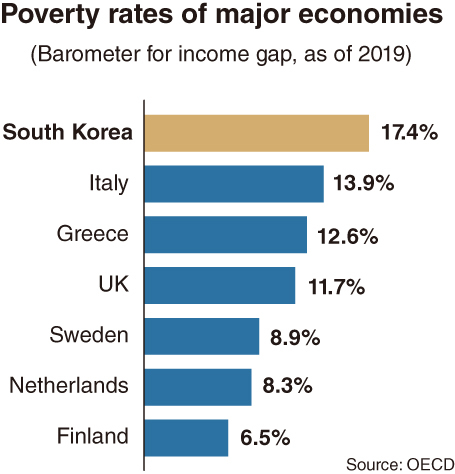[News Focus] Korea has 2nd-highest income gap in OECD
By Kim Yon-sePublished : Aug. 2, 2020 - 17:11

SEJONG -- The gulf between the haves and have-nots is wider in South Korea than in almost any other member of the Organization for Economic Cooperation and Development, a recent analysis suggests, with only the US showing greater inequality.
The OECD measured income disparities by analyzing the poverty rates of 35 of its 37 members as of 2019. (Colombia and New Zealand were excluded.)
The poverty rate is the percentage of people whose income is less than half the median household income, according to the organization’s definition. If a country’s median household income were 40 million won ($33,500) per annum, the poverty line would be 20 million won.
Korea posted a poverty rate of 17.4 percent -- the second-highest among the 35 economies analyzed. The US poverty rate stood at 17.8 percent.
Further down the list were Greece (12.6 percent), Portugal (10.7 percent), Poland (9.6 percent), Slovenia (8.5 percent), Hungary (8 percent) and Slovakia (7.3 percent).
Other countries with poverty rates lower than Korea’s included Turkey (17.2 percent), Mexico (16.6 percent), Latvia (16.6 percent), Estonia (15.8 percent) and Japan (15.7 percent).

Among English-speaking countries, the UK, Canada and Australia were at similar levels with 11.7 percent, 12.1 percent and 12.4 percent, respectively.
Polarization between the haves and have-nots in Korea has continued to widen over the past few years.
A research analyst said “the nation’s middle-income bracket has collapsed, and a large portion of middle-income households should be reclassified as part of the low-income bracket.”
Meanwhile, the poverty rate for “seniors,” defined by the OECD as people aged 66 or over, was much higher in Korea. In this age group Korea topped the list with 43.8 percent, far surpassing the corresponding figures for the US (23.1 percent), Japan (19.6 percent), Sweden (10.9 percent), Spain (10.2 percent) and Italy (9.7 percent).
Denmark and Iceland both recorded the lowest poverty rate for seniors, 3 percent. Next-lowest were the Netherlands at 3.1 percent, France at 3.6 percent, Norway at 4.3 percent and Slovakia at 4.8 percent.
While the Moon Jae-in administration recently created a huge number of public-sector jobs for seniors, the poverty rate among older people had climbed to 47.4 percent as of September 2019, according to Statistics Korea.
For young people up to the age of 17, Korea posted a poverty rate of 14.5 percent -- not far behind the corresponding figures for other developed countries.
The UK’s youth poverty rate stood at 12.4 percent, Australia’s at 13.3 percent, Luxembourg’s at 13.9 percent, Japan’s at 13.9 percent and that of the US at 21.2 percent.
But many of the 35 countries posted youth poverty rates of less than 10 percent. Among them were Sweden with 9 percent, the Czech Republic with 6.8 percent, Norway with 8.1 percent, Slovenia with 6.4 percent, Denmark with 3.7 percent and Finland with 3.5 percent.
According to an opposition party lawmaker citing data from Statistics Korea, households in the top 20 percent income bracket saw their monthly earnings increase by an average of 966,000 won in 2019 over 2017.
In contrast, the average monthly income for the bottom 20 percent fell by 108,000 won in the corresponding period -- from 790,000 won to 682,000 won.
By Kim Yon-se (kys@heraldcorp.com)


















![[Today’s K-pop] Treasure to publish magazine for debut anniversary](http://res.heraldm.com/phpwas/restmb_idxmake.php?idx=642&simg=/content/image/2024/07/26/20240726050551_0.jpg&u=)